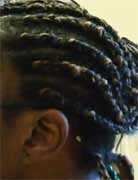
MONDAY, Dec. 17 (HealthDay News) — For black women, a desire to protect expensive and often fragile hairstyles can be a barrier to exercise, new research suggests.
The finding is gleaned from responses to a small poll conducted among roughly 100 U.S. black women. The upshot: At one time or another, about 40 percent said they have avoided running, swimming and other gym-related endeavors out of concern for their hairdo.
“There are a lot of barriers to getting enough exercise among men and women of all ethnicities, including finding time, meeting child care needs, and cost and safety,” said study author Dr. Amy McMichael, a professor in the department of dermatology at the Wake Forest School of Medicine in Winston-Salem, N.C. “But we found that hair concerns among African-American women is itself a real issue that needs to be added to the list.”
“Now I’m not saying that this isn’t also a concern among other ethnicities,” added McMichael, also the department’s interim chair. “I’m sure it is. But like everybody, African-American women want to have hair that they feel is acceptable on a daily basis. And whether it’s straight-styled, heat-styled or chemical-styled, coarse and curly hair is not something that is easily handled, especially when it gets wet.”
“So this investigation,” she explained, “is meant to open up a discussion about the practical obstacles we face in getting African-American women and all women of all ethnicities — many of whom are coming in overweight and with early hypertension [high blood pressure] and diabetes — involved in a healthier lifestyle that involves exercise.”
McMichael and her colleagues discuss their findings in the Dec. 17 online issue of the Archives of Dermatology.
The authors say that it’s long been observed that black women, as a group, are the least likely to adhere to routine exercise guidelines issued by the U.S. Centers for Disease Control and Prevention and the American College of Sports Medicine.
About 20 percent to 36 percent of black women now meet recommendations advocating 150 minutes per week of moderate-intensity aerobic activity or 75 minutes of high-intensity aerobics, as well as twice-weekly strength training, according to study background information.
The authors focused on 103 black women between the ages of 21 and 60 who completed a 40-question survey that explored both their hair-care routines and their typical exercise regimens.
Although all the women acknowledged that exercise is important, more than a quarter said they never exercised at all, while more than one in two reported activity levels that fell below public heath thresholds.
Pricey and complicated hair issues did appear to tamp down on the will to exercise. For example, 62 percent of women said they typically had their hair chemically relaxed, a time-consuming process known to increase hair fragility, particularly during washing. Many also engaged in multiple forms of hair care practices — involving various combinations of chemical relaxers, braiding, flat ironing and wigs — that led them to limit hair-washing to once a week or every other week.
Perhaps as a consequence, more than half said they often grappled with scalp issues, including itching and hair breakage, while flaking and scaling affected nearly a third. And nearly a third responded that the sweating and humidity that comes with physical activity aggravates scalp problems such as itching.
Nearly 36 percent said that a desire to maintain their hair styles caused them to stay away from swimming or other water-based activities, while about 29 percent bypassed aerobics and other gym-based sports for the same reason.
Yet, while 38 percent said that hair concerns had driven them to avoid all exercise on occasion, 50 percent said they had made an effort to modify their hairstyle so that they could exercise.
For his part, Gary Bennett, an associate professor of psychology, global health and medicine in department of psychology at Duke University, suggested that such hairstyle adjustments could be key.
“This is a serious issue,” he said. “Those of us who have worked in black communities have observed this for a long time, and there aren’t many easy answers.”
“But of the available options probably the easiest is to change one’s hairstyle,” said Bennett, who also serves as director of the Duke Obesity Prevention Program. “That could mean holding their hair in a ponytail. Or pulling it up into a bun style. And some women might want to try and plan to be more active at times before they’re about to style their hair, and maybe less so right after it’s done. Because in the end, it comes down to helping women balance their lifestyle needs with an interest in being healthy. And sometimes that requires a little bit of a trade-off.”
More information
For more on physical activity recommendations, visit the U.S. Centers for Disease Control and Prevention.

